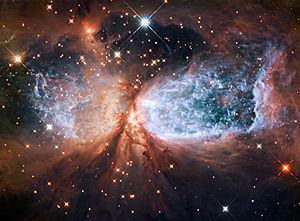Compact star facts for kids
In astronomy, a compact star is a super dense object found in space. These objects are what's left after a star dies. They include white dwarfs, neutron stars, and black holes.
Compact stars are very small for their huge weight. This makes them incredibly dense. Imagine squeezing something as heavy as our Sun into a ball the size of a city! The term "compact star" is often used when scientists know an object is super heavy and small, but aren't sure exactly what it is.
How Compact Stars Form
Compact stars usually form when a star reaches the end of its life.
Most stars shine because of nuclear fusion happening inside them. This fusion creates an outward push that balances the star's own gravity. But eventually, a star runs out of fuel. When this happens, the outward push stops. The star then collapses under its own massive weight. This collapse creates a very dense object, which we call a compact star.
Compact stars don't make their own energy anymore. But they can still glow for millions of years from the heat left over from their collapse. Black holes are an exception; they don't radiate heat in the same way.
Scientists also think some compact stars might have formed very early in the Big Bang!
How Long Compact Stars Last
Compact stars can last for an incredibly long time. Even though they cool down and lose energy, they don't need heat to keep their shape, unlike regular stars. They can exist almost forever, unless something outside disturbs them.
Black holes are believed to slowly evaporate over trillions of years. This process is called Hawking radiation. Scientists believe that in the very distant future, all stars will eventually become cool, dark compact stars. This will happen when the Universe enters a phase called the degenerate era.
The idea of "compact objects" can also include smaller, solid things like planets, asteroids, and comets. In the end, all matter in the Universe is expected to become some form of compact object.
Images for kids
-
The Crab Nebula is what's left after a supernova explosion. It contains a Crab Pulsar, which is a neutron star.
See also
 In Spanish: Estrella compacta para niños
In Spanish: Estrella compacta para niños





